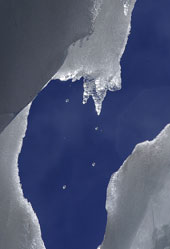 |
| Hot debate: A close up of the Sindipumba glacier on the northern side of Cotopaxi volcano in Ecuador |
Is global warming nonsense? That’s what best selling author Michael Crichton in his new book State of Fear argues. Crichton debunks the theory that rapid climate change is being driven by a build up of human-produced carbon dioxide in the atmosphere.
With that he joins the thousands of dissenting voices on the subject. Get on the internet and you stare at a brave and often not prudent world of disbelievers. That is the subterranean world of suppressed opinion ? both scientific and non scientific ? on the matter of global warming.
One such site is Johnstonarchive.net, which asks the mocking query: “What if all the ice melts?” If we keep using cars, the ice caps will melt and we’ll drown. This is a myth just as false as fearing that the sun will die as a result of using solar power, Johnston, a physics scholar at the University of Texas in Dallas whose website this is, states.
Johnston maps all the ice cover in the planet and says there are about 30,000,000 cubic km of ice in the world’s ice caps and glaciers. He says that during the last Ice Age the maximum glaciation was found around 16,000 BC when ice sheets covered all of Canada and much of the American midwest and northeast, all of Scandinavia and some regions of Eurasia. The volume of ice was two to three times as much as today’s volume and the sea level was 120 meters lower than the what is is present.
He says that today’s balance between ice caps and the global sea level has been steady since 1000 BC but the climate could change in the next 1,000 years. Not only is there a possibility of ice melting in the next 1,000 years but another Ice Age is equally possible. He derives hope from the fact that it took 18,000 years to melt 60 per cent of the ice from the last Ice Age.
Johnston says that the United Nations’ Intergovernmental Panel on Climate Change (IPCC) has been predicting global warming and has exaggerated the potential for sea level rise. He refers to scientific abstracts from various sources to say that the Antarctic ice has been growing, rather than shrinking. In fact, were the climate to get warmer in the next few centuries, current models suggest that Antarctica would gain ice with increased snowfall, more than offsetting any increased melting.
Myths and facts
On January 17, 2005, a University of Colorado site published an open letter by Chris Landsea, a member of the IPCC, saying that she had been forced to walk out of the committee as it had become politicised. Her immediate provocation for quitting the panel was that a press conference was called where it was said that the experts had come to the conclusion that global warning was impacting hurricane activity today.
“To my knowledge none of the participants in that press conferene had performed any research on hurricane variability,” she says.
Moreover, the evidence is quite strong and supported by the most credible studies that any impact in the future of global warming upon hurricanes will likely be quite small, she says.
These are not the only dissenting voices on global warming. The site of the Centre for Public Policy Research, a Washington-based non profit body, lists the myths and facts on global warming.
Myth one: 2,500 of world’s leading scientists agree that human induced global warming is under way. “The fact is there was never such a group. Thousands of people endorsed the findings of the IPCC in 1995 which said that there was some human influence on climate change. But most of these people were not scientists but social scientists, economists, public relations experts and government functionaries. In fact, no more than 100 climate scientists are listed among the IPCC report’s signatories,” it says.
Myth two: the planet’s temperature has warmed as human emissions of carbob dioxide have increased. The opposite has occurred. Since the end of the Little Ice Age in the mid-19th century, the temperature has increased by 1.5 ?F. A full one degree of this warming occurred before 1940 when fossil fuels were used less than today. Since the warming started 100 years ago, it has in fact begun to reverse with the planet having cooled by .01 ?C or .018 ?F since 1979.
In 1997, New Scientist did a story The Greenhouse Wars, on global warming and climate change sceptics. The article described the sceptics thus: “They’re among the world’s top scientists. They don’t believe in global warming. And they think their time has come.” Pat Michaels, a belligerent sceptic of global warming, says in the article: “The truth is that what we sceptics say is always pilloried by the climate modellers and then adopted as their own five years later.”
The article says: “Michaels, a climatologist at the University of Virginia, is convinced that the tide is about to turn in his favour, and that the efforts of the mainstream climate modellers, stalwarts of the UN’s Intergovernmental Panel on Climate Change, are about to collapse under the weight of their own inconsistencies.” The New Scientist goes on say that the facts seem to favour the dissidents: “But the stubborn failure of most of the troposphere to warm continues to hearten the greenhouse outlaws. Are they right? Has the climatic apocalypse been postponed?”
Divided camps
In the greenhouse wars, the battle is bloody and many a good scientist has been conscripted by both sides, it said, citing the example of John Christy. “For 10 years he was a Baptist minister in Kenya before he took up science. Now, as professor of atmospheric science at the Global Hydrology and Climate Center, part of the University of Alabama in Huntsville, he catalogues data from satellite instruments operated by the US government’s National Oceanic and Atmospheric Administration (NOAA). Since 1979, long before global warming was an issue, NOAA’s instruments have been measuring microwave radiation released by the atmosphere. The radiation comes largely from oxygen molecules, which release more as they warm, giving an overall picture of temperatures in the troposphere. So far, and in stark contrast with the ground-based meteorological stations, the satellites have apparently picked up little evidence of warming.”
Naturally, the sceptics have adopted Christy’s data to suggest that global warming is a myth. In response, collectors of ground-based data have hit back, said the article.
Both are wrong, says an exasperated Christy. “The satellites don’t measure surface temperatures, but average temperatures through the troposphere.” Thus the surface and satellite data complement rather than contradict. Put them together, he says, and they show that the surface of the planet is warming, but the bulk of the troposphere, the so-called free troposphere, is not, says Christy.
Common ground
Pat Michaels, the climatologist, told New Scientist that there can be a common ground. He and other sceptics suggest a doubling of carbon dioxide in the atmosphere would raise average temperatures by between 1 and 1?5 ?C. And 1?5 ?C is the bottom end of the modellers’ range of predictions. But then he says that you can’t make a case for a global apocalypse out of a 1?5 ?C warming. “It destroys the issue. If politics weren’t driving this, we could all meet on common ground.”
In February 2005, days before the Kyoto Protocol asking countries to cut green house emissions came into effect, New Scientist took another look at what the sceptics said on the subject. Its cover story Menace or myth said: “Could the sceptics be onto something? Are we after all being taken for a ride? This is the most crucial scientific question of the 21st century and the winning side will shape economic, political and technologial development for years, even centuries, to come.”
In India, Dr Krishan Kumar, who heads the department on climate change at New Delhi’s Jawaharlal University, says that some of the concerns raised by these websites are valid. People tend to say that climate change would be disastrous. But this is an exaggeration for it is not going to be disastrous in every sphere. While man has contributed greenhouse gases, the temperature too is changing naturally, he says.
He also accepts the concerns raised by many of these websites regarding politicians, the media and the non-scientist community hijacking a purely scientific exercise.
“We cannot say when a warming trend started and it is baseless to say that greenhouse gases started it,” he says. Kumar says that climate change is a reality and while some concerns are valid there are many positive aspects of global warming too. Science and politics are being mixed up, he concludes.











